How to Grow Spinach for Beginners
If you are looking for tips on How to Grow Spinach for Beginners you are in the right place. Spinach is an amazing green that you can use in your salads, cooking dishes, and even smoothies!
Another great veggie to add to your gardening 101list that you can use to grow all the food you need in your own backyard.
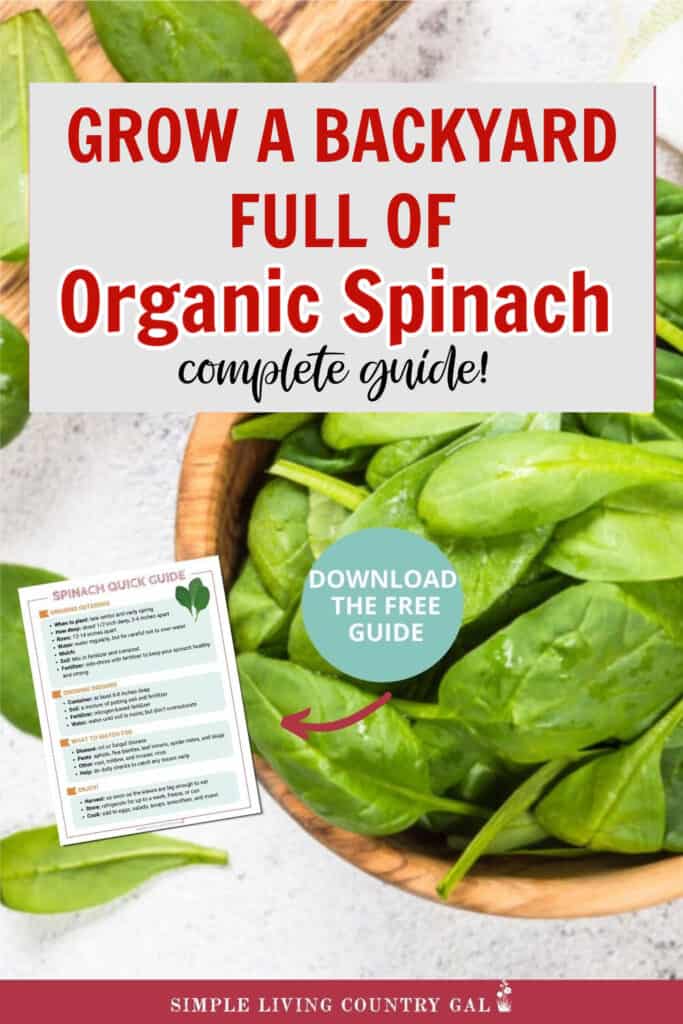
One of the main reasons I began gardening was so I could provide a large variety of delicious organic vegetables to my family that I knew without question what exactly went into each plant’s growth.
If you are looking to improve your health, learning how to grow spinach for beginners is a great place to start. Whether you have grown spinach for years or have yet to give it a try, this article will walk you through just what you need to do in order to grow healthy and organic spinach in your vegetable garden this year.
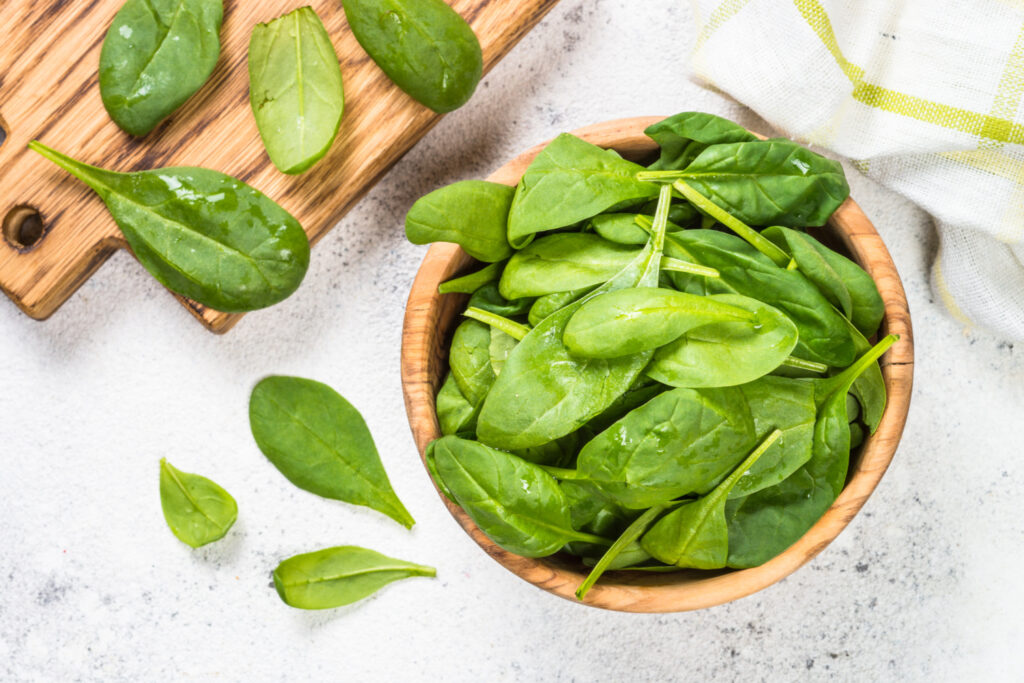
Growing spinach is fairly easy, whether you want to grow indoors in hydroponic garden systems, outside in a traditional backyard garden, or right outside your kitchen door in a variety of containers. Partner the fact that it’s so beneficial to our health and easy to grow, it’s a great option for feeding your family nutritional and delicious meals from the garden to your table.
Spinach is known as one of those superfoods because of the many health benefits it provides. A 100g serving of raw spinach provides 2.8g of protein and 2.8g of fiber for only 25 calories. Just the look of it tells you how amazing it is.
Its dark green color provides healthy carotenoids, providing both anti-inflammatory and anti-cancerous properties. Spinach also has high levels of iron, anti-oxidants, and vitamins K, A, and C to support a healthy immune system. And if that’s not enough, it also supports brain health and lowers blood pressure.
You can use spinach in so many ways in your kitchen that you’ll never get bored eating it. Serve it up raw for a delicious salad or cooked and stuffed in chicken, tossed in soups, or served in omelets. The possibilities are endless.
What to Know When Growing Spinach
Spinach (Spinacia oleracea) is a cool-weather vegetable but can be grown indoors all year long. It’s related to beets and Swiss chard. It’s a fairly fast-growing plant that yields a lot of leaves in a short period of time.
Depending on temperatures and whether you’re growing inside or out, you can expect a plentiful harvest of your spinach in about 6-8 weeks.
What You Need to Grow Spinach
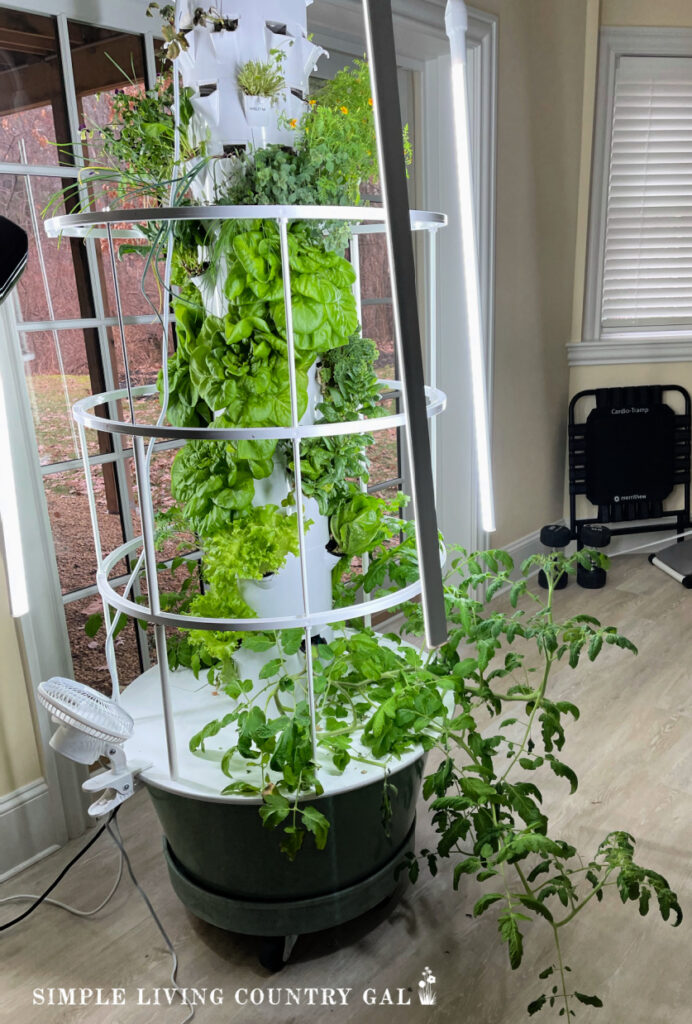
Spinach grows well both indoors and outside. You can plant in pots or directly in the ground. If you are not sure which method to use, there are a few factors that can help you decide:
- What are the temperatures in your area?
- How much space do you have?
- Do you want to harvest all year?
- How many people are you feeding?
Indoor and outdoor container gardening will produce a smaller harvest but it’s perfect if you have a small family or your space is limited. If you have the space, an outdoor in-ground garden may be a better option for a larger family.
Temperature
Spinach is a cool-season annual so that means it grows best in spring and fall seasons outdoors. If you live in a region where you experience mild winters, spinach will grow well then too.
If you’re starting your seedlings indoors to move outside, it is best to start them about 6-8 weeks before the last average frost in spring. If you are not sure you can check your hardiness zone timeframes in your area. Once your seedlings are healthy and strong, you can then transplant outdoors about 4 weeks before the last frost. Be sure to take care with the root system when transplanting though as seedlings can suffer transplant shock.
READ: How to Harden up New Seedlings Before Planting Outdoors
In regions with mild winters, you will do best to plant spinach in late summer or early fall about 6-8 weeks before the first frost for a fall harvest.
In colder regions, spinach can survive the winter in a cold frame or under thick mulch. The plants will come back in the warmer weather of spring.
Sun
Spinach prefers full sun but if you live in a warmer region where summer is especially hot, it will grow fine in partial shade. If you’re growing in the fall, try to choose a spot that will get plenty of sun throughout the day as the days are shorter.
For spring and summer planting, you can choose a spot that gets partial shade in the late afternoon to keep the leaves from burning from too much sun. If you live in an area that’s especially hot and sunny in the summer, choose an area that gets some shade.
Soil
Planting spinach in soil that is rich in organic material and drains well is your best option for success. Compost with a pH of 6.5 to 7 is best. To improve your soil, you can add a layer of compost over your existing soil.
If planting in a container, use a potting mix that is rich in organic materials. The soil should be a bit crumbly. Well-draining soil is the most important factor to any type of planting so avoid soil that remains waterlogged or gets clogged in the drainage.
Watering
Spinach doesn’t like overly watered soil, but it does enjoy evenly moist soil throughout the growing season. Keeping the soil moist, but not overly watered will help the spinach grow quickly. Try to avoid splashing mud on the leaves, this will weigh them down and increase the chances of disease. To prevent this, it helps to mulch around the plants with straw, newspaper, fresh-cut grass, or chopped leaves to protect them. Side dress the plants with compost tea every two weeks during the growing season to continue to provide nutrients.
If you’re growing spinach in containers, you will want to avoid water stagnation; it can lead to rot and fungal diseases.
Water stagnation is when water sits in a pool at the bottom of a container. To help prevent this you need to be sure your containers have good drainage. Most containers are set up for drainage already, if not you can drill in holes or add in a layer of small rocks to keep the roots better protected.
Fertilizing
Spinach grows best in well-fertilized soil. When fertilizing be sure you have an adequate amount of nitrogen to develop the dark green leaf color that spinach is known for. Before planting, add a general garden fertilizer, such as a 10-10-10, at about 2-3 pounds per 100 square feet.
A 15-10-10 fertilizer is an even better option if you have it available. Mix the fertilizer into the soil at about a 3-inch depth. Fertilize again about a month after the plants start to come up. If you are not sure you will remember, a calendar is a great way to schedule your gardening chores.
Before planting, add a granular fertilizer to the soil. Once the plants are established, switch to a water-soluble fertilizer. This will make it easier to feed the plants without disturbing their shallow root system. If you prefer to use a granular fertilizer during the growing season, it should be used as a side dressing.
Lay it along the edge of the rows about once a month. You will want to be sure that you keep the granules from coming in direct contact with the leaves as it will burn them. Finally, after applying the fertilizer, water immediately so it can absorb into the soil.
How Much Spinach to Plant?
When it comes to growing spinach I like to follow the “Plant more than you need” rule. You probably know what I mean if you’ve ever cooked spinach. A recipe may call for a frighteningly large amount asking you to shove it into a pan that is plainly too small. But after a few minutes, all that spinach cooks down to a surprisingly small amount.
The reason why this happens is that spinach is mostly water meaning it will cook down to almost nothing. If you’re planning on using spinach in some of your recipes, you’ll want to grow plenty of it. On average, you should plan on 15 plants for each family member in order to have a regular and plentiful harvest.
When to Plant Spinach
There are several times a year that you can plant spinach for a bountiful harvest which means you will want to plant multiple times to keep your crop going strong. Late winter and early spring planting will provide a fast crop early in the season. You can then plant again in late summer or early fall after the hottest weather has passed.
SLCG PRO TIP: Remember, spinach is a cool-weather plant so it likes the milder, cooler temperatures rather than hot steamy ones.
Spinach is an annual crop meaning each plant will grow for a full season then die off. This means that you will need to start new plants from seeds at the beginning of the growing season.
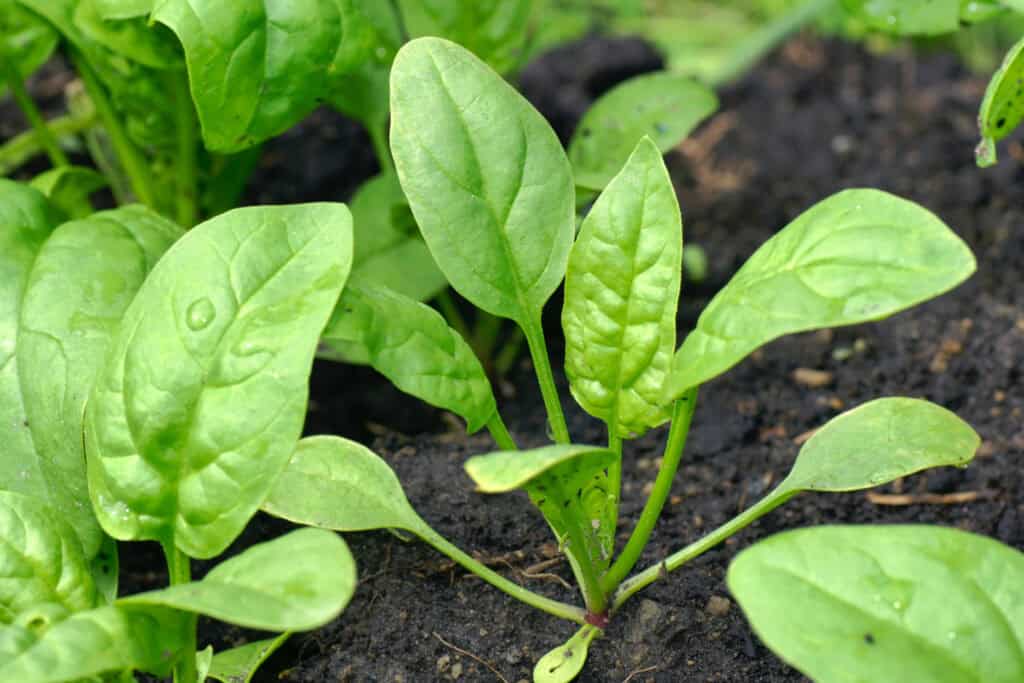
How to Plant Spinach
SLCG PRO TIP: Refrigerating your spinach seeds for a week before planting can help them germinate faster.
When growing in the ground, prepare your soil by mixing in fertilizer or compost first. If you are not sure what your soil needs, you can read more on that here:
READ: How to Prepare Your Garden Soil for Planting
When planting you don’t need to dig deep; spinach seeds only need about a half-inch of depth. Plant your seeds in rows, keeping your seeds 2-4 inches apart and your rows about 12-14 inches apart.
Next, cover the seeds with about half an inch of soil. Be sure to label your rows so you know what is where, as your garden grows.
Spinach seeds will germinate in about 5-10 days at 70 degrees Fahrenheit, about 21 days at 50 degrees.
As your plants start to grow, you will want to thin out any seedlings that aren’t growing well. I know this part is hard to do, even I struggle with it myself, but it is important to remember that removing the weakest seedlings will provide more nutrients to the strongest ones. To thin, simply cut them off at soil level. Do not pull to thin out your plants as this will risk damage to the plants you hope to keep.
Water regularly, being careful to not overwater. Doing so will oversaturate the soil risking damage to the plant’s roots.
As your plants grow remember to side-dress with fertilizer to keep your plants healthy and strong. Set up a calendar with your fertilizing schedule so you don’t forget.
How to Grow Spinach Indoors
Spinach can grow very well indoors all year long. With potting soil or hydroponics, containers, seeds, and the right amount of water and fertilizer, you can grow a healthy crop any time of the year.
To grow indoors you will first want to choose your container. In this case, the depth is more important than the width, you’ll want at least 6 inches in depth but 8 inches is better.
For the soil, use a mixture of potting soil and fertilizer to fill your container and make sure it has a good drainage system. Make sure your potting soil has lots of organic matter, loamy and crumbly soil are best. Make sure the pH level is as close to neutral as possible and that it drains well. Nitrogen-based fertilizer is a good option. You’ll want to continue to fertilize as your plant grows so reapply it to the soil after your spinach has sprouted but before it finishes growing.
Plant your seeds about a half-inch deep. They should start to sprout sometime between 5 days and 2 weeks. Make sure you give your plants plenty of space to spread out as they grow. Keep your seeds about 5 inches from each other to make sure your plants won’t overcrowd each other.
Place your container in an area that gets full sun in cooler temperatures and partial shade in extremely hot temperatures. You’ll also want to look for a full sun area when the days are shorter to make sure your plants get the maximum amount of sun they can.
As for temperatures, the germination of seeds can begin anywhere from 40 degrees to 75 degrees Fahrenheit. Just because they can grow at 40 degrees though doesn’t mean they should. Try to keep temperatures between 50 and 60 degrees for best growth.
Lastly, your plants will need plenty of water to thrive. But don’t just dump a cup of water on the soil and walk away. Water your soil until it’s moist but don’t let it get oversaturated in any area and keep the water off the leaves.
With these tips, you should be able to enjoy a healthy spinach harvest indoors.
How Long Does It Take Spinach to Grow?
With the proper temperatures, watering, and fertilizer, you can expect to harvest your spinach crops in about 6-8 weeks from planting. Outdoor planting is best, either in your garden or in pots, to allow for the proper temperatures, but it can grow well indoors as well if the conditions are right.
Things to Watch for When Growing Spinach
· Spinach can develop rot or fungal diseases at the root with too much watering so it’s best to water a little at a time then water again when needed versus watering a lot at once.
· Spinach can also be attacked by aphids, flea beetles, leaf miners, spider mites, and slugs. Pinch out any heavily infested foliage. Spray flea beetles and spider mites with Spinosad. To keep slugs away, sprinkle a barrier of diatomaceous earth around the plants.
· Spinach is susceptible to rust, mildew, and mosaic virus. Look for varieties that are rust and disease-resistant. Mildew and rust are fungal diseases. To get rid of them, spray-mist the leaves with compost tea.
Plants that are hit with the mosaic virus should be completely removed from the garden to prevent spreading. The mosaic virus can be spotted as it will cause the leaves to be mottled or become streaked with yellow or white.
Additional Planting Notes
· Keep your plant beds free of weeds; these can steal light, nutrients, and water from the spinach.
· Spinach can be harvested as soon as the leaves are big enough to eat. Cut the older, outer leaves first to allow the remaining young leaves to mature.
· If you harvest an entire plant, cut the leaves 3 inches above the soil. This will allow new leaves to grow for a second harvest.
· Large, older leaves can be bitter so it’s best to harvest sooner rather than later.
· Wash your spinach thoroughly to eliminate any grit that may stick to them. Your fresh spinach can be refrigerated for up to a week or it can be frozen, canned, or dried.
· Spinach seeds can be sprouted for a new plant.
Enjoying Your Home Grown Spinach
The best way to enjoy your freshly picked spinach is in a salad for your dinner table. Try to use spinach right when it’s picked to get all those amazing health benefits it has to offer.
Spinach is great sauteed, in salads, 0n pizza, pasta, and in soups.
You can also freeze spinach in freezer bags and use it in your morning smoothies. To freeze, wash and allow to dry before freezing. Put into freezer bags and remove as much air as possible. The less air you have the longer your spinach will stay good in your freezer. You can also use a straw to suck out the air and seal. Be sure to label your bags with their name and date.
Not a fan of using a straw? Then a vacuum sealer is a tool you may want to look into. Not only is it great for freezing produce from your garden, but it also works well with meat, bread, poultry, and pork.
When making a smoothing add a handful of frozen spinach leaves to give an extra nutritional boost. Don’t worry, you will not taste the spinach in any way but it will give a green color to your drink. Store spinach in the freezer for up to 12 months.
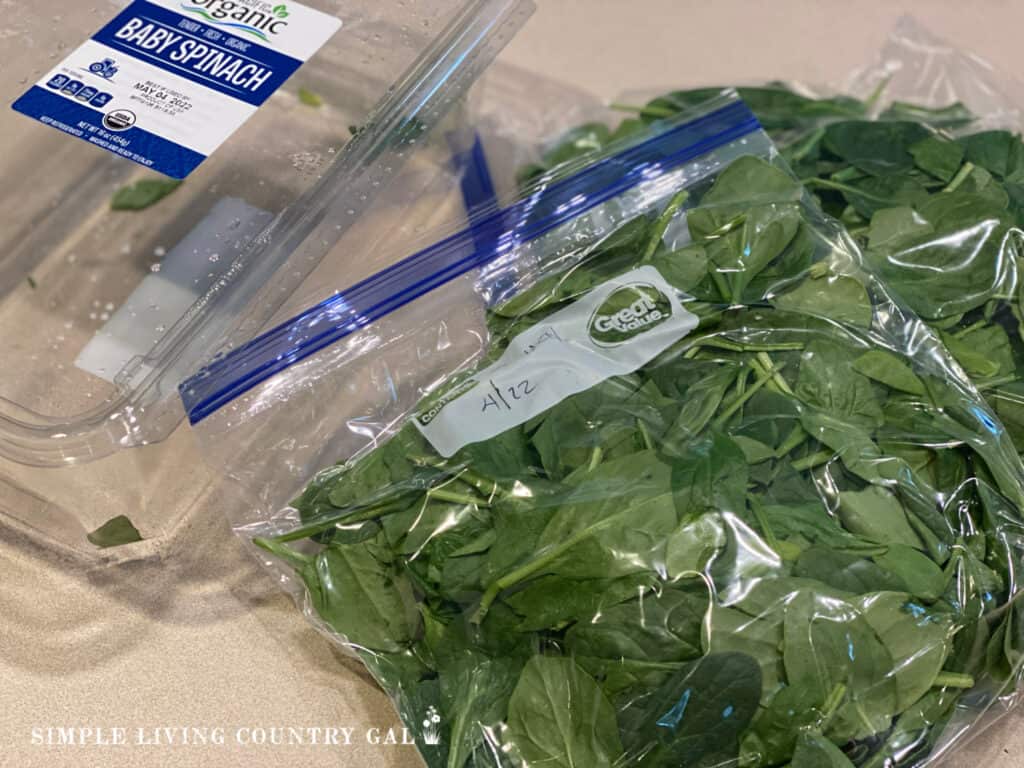
Another option is dehydrating spinach, this is a great article that will walk you through each step. This option also lasts for up to 12 months in your pantry. If you do not have one yet, look into investing in a good kitchen dehydrator. This is a great tool to have so you can same more food options in your kitchen pantry.
Learning how to grow spinach for beginners is easy, can be done indoors or outside, in a large garden plot, or in a container on your deck. It will feed your family plenty of nutritional meals, and in many areas, can be grown all year long.
With so many benefits learning how to grow spinach for beginners will complement your family table all summer long.
